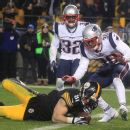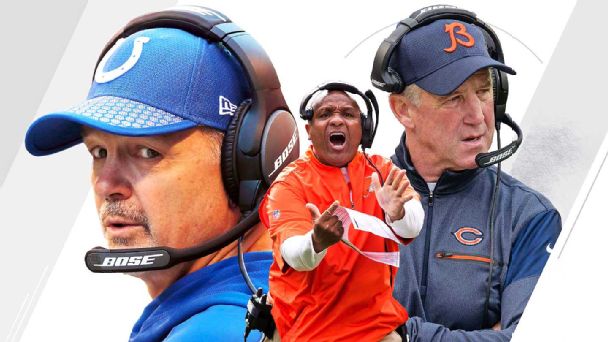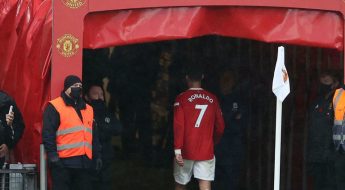Barnwell: Three options to fix the NFL's catch rule

Under the NFL’s definition of a catch, the league was right to take away what looked to be a game-winning Jesse James touchdown catch at the end of Sunday night’s Patriots-Steelers game. There are still unanswered questions — notably, if the call was as easy as the explanations of Alberto Riveron and Tony Corrente have suggested, why it took what felt like 10 minutes to overturn the call — but everyone on the league side of things seems to agree that the review was processed properly and led to the correct call.

There have been way too many controversial reversals of touchdowns this season. What happened on Sunday with Jesse James wasn’t one of them.

A dramatic ending to the Steelers-Patriots matchup turned controversial after officials overruled what appeared to be a go-ahead touchdown catch by the Steelers tight end Jesse James — a decision derided by James and several of his teammates.
1 Related
Here’s the problem, though: just about everyone who has watched a football game before also thinks James caught that football. Watch the replay. The Patriots defenders who surround James after the play aren’t arguing it’s incomplete. Bill Belichick, who would have been pictured frantically gesturing on camera in the case he thought it was a drop, isn’t depicted. Jim Nantz says “there’s no doubt it’s going to hold up,” as he and Tony Romo spend two minutes watching replays before it even occurs to them that the ball spun slightly as James hit the ground.
The rule was interpreted correctly, but the rule is bad. There are plenty of problems with the NFL right now, but many of them are either intractable or downright unfixable. The catch rule is not one of them. The NFL has to fix it, and that might require a totally radical sort of solution. Let’s make arguments for three very different types of changes to the much-hated catch rule.
Option 1: The evolution
While the NFL’s catch rules certainly aren’t perfect, they’ve evolved the way they have for a reason. Tangible in-game examples (like the Bert Emanuel rule) have driven practical changes to the laws over time. They’re never going to fix the problem and make everyone happy all the time, but no rule on paper is ever going to address every possible in-game catch situation. As a result, the league needs to be proactive about monitoring how the rule is impacting games and be comfortable making changes every year or two accordingly.
With that in mind, the league’s catch rule isn’t really all that bad over the first 99.9 yards of the field. Most of the complaints we’ve seen over the past few years, starting most memorably with the Dez Bryant catch, revolve around touchdowns and would-be touchdowns. Those plays are always going to stand out in the mind because of their importance, but they’re also where the current rules seem to fall apart.
The Calvin Johnson rule, so-called for taking a touchdown away from one of the league’s star wide receivers in Week 1 of the 2010 season, simply doesn’t work. It leaves too much up for interpretation and offers little clarity into what receivers actually need to do to ensure a touchdown. James’s catch fell short because he failed to, as Corrente described, “survive the ground.” The ball moved slightly as James hit the ground, but independent of the rulebook, it’s clear that James caught the ball, only for it to budge slightly as he leaned forward to try to push ahead of the plane.
To improve matters, let’s get rid of the surviving the ground rule and stop taking away touchdown catches for balls that narrowly drop slightly after a player’s established contact. Runners can score touchdowns just by flashing the ball over the plane of the goal line, but receivers currently need to complete their catch to the ground to become runners and qualify for touchdowns. Under our rule change, a player becomes a runner as soon as he catches it and gets two feet (or one knee or elbow or cheek, as Damiere Byrd exhibited Sunday) inbounds.
This rule isn’t perfect, but it’s an improvement. We don’t have to go back to the “football move” conundrum with this change. He doesn’t have to turn upfield or hold onto the football until his teammates have started their synchronized celebration. If the receiver bobbles the ball on the way to the ground and never actually makes a firm catch, that’s an incomplete pass. Otherwise, if he catches the ball on his feet (or back) and establishes himself inbounds, it’s a catch.
To go along with it, let’s fix the actual worst rule in football, when a fumble through the pylon becomes a turnover and a touchback for the other team. Nobody likes this rule outside of the one game every three or four seasons in which it benefits their team. The problem is that the solution of simply giving the ball back to the offense on the one-yard line basically gives offensive players a free opportunity to reach for the pylon with no repercussions, given that a swatted ball near the pylon is almost always going to go out of bounds.
Fortunately, Twitter fixed that for us. I asked about possible solutions to this problem back in October and certified genius @chiefdog10 solved our crisis with what he called the “self-touchback.” I like “reverse touchback,” but the idea’s his. When the ball is fumbled out of bounds through the pylon, don’t turn the ball over. Just push it back to the 20-yard line. I’ll add that the down should count, so the reverse touchback basically costs you 19-plus yards of field position but otherwise lets you keep the football. You’re punished for fumbling, but it’s not the eight-point swing (including the missing touchdown and the possession given to the other team) which comes with the current rule.
These changes don’t solve the catch rule problem, but they eliminate the most frustrating and confusing plays we complain about on Sundays. James’s catch would have been ruled a completion and then a momentary fumble as he hit the ground and stretched forward, which he would have then recovered. The Steelers wouldn’t have been awarded a touchdown, but they would have been able to get back on the ball at the one-inch line.
Option 2: The de-evolution
The league’s catch rule is too complicated, and all the changes we’ve made have turned it into something like an overfit model. We’re asking a lot of refs on a weekly basis as they deal with an increasingly speedy game. The current replay system makes it so that referees often rule a big play a turnover or a touchdown on the field, which creates an automatic review but one inherently likely to lead to those decisions being upheld, given that ties go to the call on the field. The widespread unpopularity and confusion surrounding the catch rule means we have to start over.
So, let’s go with what Larry Fitzgerald suggested should be the new rule two years ago. If a receiver catches the ball and gets two feet, a knee, an elbow, or a cheek on the ground, it’s a catch. If he stays upright and the ball is stripped out of his hands or he bobbles it, the ball becomes a live fumble.
Doesn’t that feel refreshingly simple and comprehensible? We still need to come up with a clear definition of “catch,” but let’s try to keep that to the shortest possible definition. Maybe it becomes a catch at the moment when the receiver grabs the ball in his hands without bobbling it. Perhaps you put a timeframe on it, like the receiver cradles the ball for a half-second or a full second.
This will unquestionably increase fumbles, which will be fodder for the tiresome and flimsy arguments about how football has always been great and is now suddenly worse. That’s fine. The league’s turnover rate has been dropping steadily for decades. Fumbles are fun plays. Everyone loves to point. Players will also adapt and begin to protect the football earlier through the catch process. It will also mean more catches, but how often do you hear people complaining that something was ruled a catch when it shouldn’t have been? We’re living in a Golden Age of receivers. Let’s reward Antonio Brown and Julio Jones for being amazing.
Option 3: The revolution
There is a group of people out there who believe that the catch rule should revolve around what Bruce Arians refers to as “common sense.” The eye test is almost always a phrase used to excuse anecdotal nonsense, but players and fans alike have seen enough football to know whether something’s a catch or not. The plays in the NFL are simply too fast for a referee to judge in real-time, and we shouldn’t be using frame-by-frame replay to judge something that happened at top speed and overturn a catch over a slight budge seconds later. There is no language capable of solving the catch rule.
So, if you know whether something’s a catch or not from watching a play in context, let’s use our eyes to decide. And since this is my idea, we’re not turning things over to a head referee to watch on video. Let me introduce you to The Committee.
Whenever there’s an NFL game going on, a committee of 50 ex-NFL players will assemble in New York (or California or some other central location). The committee will consist of 25 former receivers and 25 defensive backs. You can change the numbers however you want — maybe it’s 10 at each position or 32 players and each team can nominate a wide receiver or a defensive back in alternating years — but the idea is the same.

• Rating every head coach’s job security »
• Everything to know about potential openings »
These players have one job: whenever there is a question about a catch which is challenged via the coach’s flag or any of the automatic review situations, they get 60 seconds to watch replays of the catch and then vote “Yes” or “No.” They will be provided with whatever catch rules the NFL wants to suggest, but at the end of the day, they have one principle which overrides that concept: if they think it’s a catch, our voting panel should vote “Yes.” If not, they should vote otherwise.
And yes, before you ask: this should be treated like an episode of Who Wants to be A Millionaire. We should see the votes update in real-time on the screen, although the individual votes should be kept anonymous to the public. There should be a bunch of cameras in the room. Shine a light on each player as we get to the final few and the vote’s at 24-24 so we can watch Wes Welker and Jabari Greer agonize over their decision. Imagine the crowd roaring as they see the vote count rising in their favor on the jumbotron. This could be great television.
Players should be allowed to remain on the committee for up to 10 years, but we want to eventually find a consensus on what isn’t a catch. As a result, while the votes should remain anonymous to the public, the league should keep track of the individual votes and prevent the five players who differed from the majority most frequently from joining the committee in the future. (This would be bad if the consensus was wrong, but the consensus should be pretty in line with popular opinion with a large enough sample.
No, this won’t be cheap, and it wouldn’t be a perfect solution. I suspect referees might not take kindly to giving away this element of power. It would also make for great television, and we would have far fewer controversial calls than we do now. We’re never going to fix the catch rule. Let’s at least have some fun with it and think outside of the box for a compelling and possibly entertaining solution instead.




